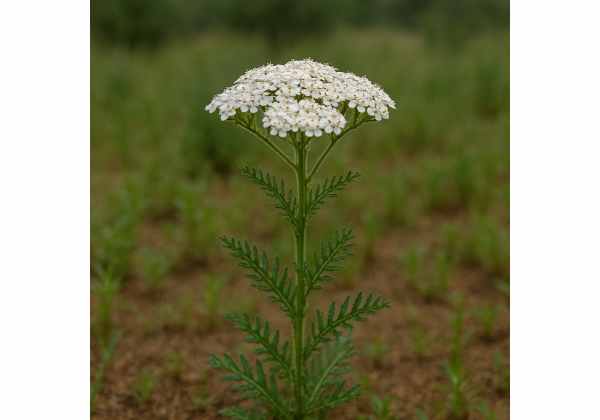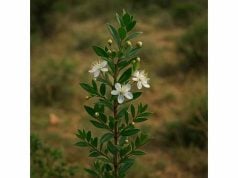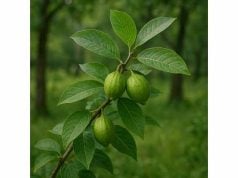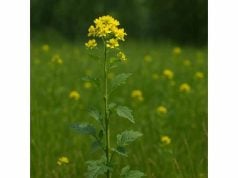
Milfoil, commonly known as yarrow (Achillea millefolium), is a time-honored herb renowned for its extensive therapeutic properties and versatile uses. Celebrated for its potent anti-inflammatory, antioxidant, and antimicrobial effects, milfoil has been traditionally used to aid wound healing, support digestive health, and reduce fevers. Rich in bioactive compounds such as flavonoids, sesquiterpene lactones, and volatile oils, this herb also plays a role in alleviating pain and promoting circulatory health. Milfoil is valued both as a culinary spice and as a natural remedy in herbal medicine, making it an indispensable resource in traditional and modern holistic practices.
Table of Contents
- Plant Profile and Identification
- Phytochemistry and Active Compounds
- Benefits and Properties
- Uses and Safety
- Scientific Research and Significant Studies
- FAQ
Plant Profile and Identification
Milfoil, scientifically known as Achillea millefolium, is a perennial herb belonging to the Asteraceae family. Widely distributed across temperate regions of the Northern Hemisphere, it thrives in meadows, roadside verges, and disturbed soils. This robust herb typically grows to a height of 60–90 centimeters and exhibits an erect, branching habit. Its finely divided, feathery leaves—hence the name “millefolium,” meaning “thousand leaves”—are soft, green, and aromatic. The leaves’ delicate structure maximizes surface area, allowing for efficient absorption of sunlight and air, which contributes to the plant’s vigorous growth.
During its flowering period in mid-summer, milfoil produces clusters of small, white to pale pink composite flowers arranged in flat-topped inflorescences. These blooms are not only attractive to pollinators such as bees and butterflies but also contribute to the herb’s longstanding ornamental appeal. The plant’s fibrous root system enables it to withstand drought conditions and regenerate rapidly after disturbances, making it a resilient component of wild landscapes.
Historically, milfoil has been revered in various cultural traditions. Ancient healers and herbalists prized the herb for its wound-healing properties, a legacy that continues in modern herbal medicine. Traditional lore even attributed mystical qualities to milfoil, linking it to courage and protection in battle—a belief reflected in its Latin name “Achillea,” derived from the legendary Greek hero Achilles.
Modern botanists have extensively studied milfoil for its ecological and medicinal attributes. Its adaptability to diverse habitats—from nutrient-poor soils to well-tended gardens—has made it a subject of interest in ecological restoration projects and sustainable agriculture. Moreover, its ability to thrive without heavy chemical inputs has positioned milfoil as a symbol of natural resilience in an era of intensive farming practices.
In addition to its environmental benefits, milfoil’s robust appearance and medicinal history have secured its place in both traditional and contemporary phytotherapy. Gardeners and herbalists cultivate it not only for its practical uses but also for its aesthetic contribution to natural landscapes. Its gentle, aromatic presence is often a welcome addition to herb gardens, where it pairs well with other medicinal and culinary herbs.
Overall, the botanical profile of milfoil is a testament to its enduring value. Its adaptability, striking appearance, and historical significance continue to inspire both scientific inquiry and practical applications in modern herbal medicine and sustainable agriculture.
Phytochemistry and Active Compounds
Milfoil’s impressive health benefits are rooted in its complex phytochemical composition. A wealth of bioactive compounds works in synergy to deliver its therapeutic effects. Key constituents include:
- Flavonoids:
Milfoil is rich in flavonoids such as quercetin, luteolin, and apigenin. These compounds are renowned for their potent antioxidant properties, which help neutralize free radicals, reduce oxidative stress, and support overall cellular health. Their anti-inflammatory action further contributes to mitigating chronic inflammation and protecting cardiovascular health. - Sesquiterpene Lactones:
Compounds like achillicin and millefin are characteristic of milfoil’s sesquiterpene lactone content. These molecules exhibit anti-inflammatory, analgesic, and antimicrobial properties. Research suggests that they play a pivotal role in modulating immune responses and reducing pain, particularly in conditions such as arthritis. - Volatile Oils:
Milfoil contains essential oils that give the herb its distinctive, mildly bitter aroma. These oils include compounds such as camphor and borneol, which contribute to its antimicrobial and antispasmodic activities. The volatile oils are responsible for many of its traditional applications in aromatherapy and topical formulations. - Tannins:
Tannins in milfoil exert astringent effects that are beneficial for wound healing and digestive health. They help tighten tissues and reduce excessive fluid loss, while their antimicrobial properties further aid in preventing infections, particularly in skin applications. - Phenolic Acids:
Phenolic acids like caffeic acid and chlorogenic acid are present in milfoil and contribute significantly to its antioxidant capacity. These acids assist in reducing inflammation and protecting against oxidative damage, thereby lowering the risk of chronic diseases. - Alkaloids:
Although present in smaller amounts, certain alkaloids in milfoil may contribute to its overall bioactivity. These compounds are thought to enhance the herb’s antimicrobial and anti-inflammatory effects, supporting its traditional use as a natural remedy for various ailments.
The concentrations of these compounds can vary depending on environmental factors, cultivation practices, and the timing of the harvest. Modern extraction methods such as high-performance liquid chromatography (HPLC) and gas chromatography-mass spectrometry (GC-MS) are used to ensure the standardization of milfoil extracts, guaranteeing consistent potency and quality in commercial products.
The interplay among these diverse phytochemicals underpins the multifaceted therapeutic profile of milfoil. For instance, the combination of flavonoids and phenolic acids not only enhances its antioxidant defenses but also contributes to its ability to modulate inflammatory processes. Similarly, the presence of sesquiterpene lactones and volatile oils synergizes to produce a potent antimicrobial effect that supports both internal and topical applications.
As research continues to explore the molecular mechanisms of these compounds, milfoil remains a subject of keen interest in the fields of phytotherapy and nutraceutical development. Its complex chemistry offers promising avenues for the development of new herbal formulations aimed at preventing and managing chronic health conditions.
Benefits and Properties
Milfoil has been utilized for centuries in traditional medicine, and modern science increasingly validates its diverse health benefits. Its multifaceted properties contribute to its widespread use in holistic wellness practices. Here are some of the principal benefits and properties of milfoil:
Antioxidant Protection:
The high concentration of flavonoids and phenolic acids in milfoil provides robust antioxidant activity. By neutralizing free radicals, these compounds protect cellular components from oxidative damage, thereby reducing the risk of chronic diseases such as cardiovascular disorders and certain cancers. This antioxidant property also plays a vital role in slowing the aging process and maintaining overall cellular health.
Anti-inflammatory Effects:
Milfoil’s sesquiterpene lactones and volatile oils help to reduce inflammation by inhibiting pro-inflammatory enzymes and cytokines. This makes the herb an effective natural remedy for inflammatory conditions such as arthritis, inflammatory bowel diseases, and other chronic inflammatory disorders. Its anti-inflammatory effects also contribute to its pain-relieving properties, making it a valuable adjunct in managing musculoskeletal discomfort.
Wound Healing and Skin Regeneration:
Traditionally, milfoil has been applied topically to promote wound healing and reduce skin inflammation. The astringent properties of tannins help tighten skin tissues, while the antimicrobial activity of its essential oils prevents infection. These combined effects accelerate tissue repair and improve the overall appearance of the skin, making milfoil a popular ingredient in natural skincare formulations.
Digestive Support:
Milfoil is known for its carminative properties, which help to soothe the digestive tract, reduce bloating, and alleviate indigestion. Its mild antimicrobial action supports a balanced gut flora, promoting efficient digestion and nutrient absorption. This digestive support is particularly beneficial for individuals suffering from gastrointestinal discomfort or mild digestive disturbances.
Cardiovascular and Circulatory Health:
The antioxidant and anti-inflammatory properties of milfoil also extend to cardiovascular health. By reducing oxidative stress and inflammation in blood vessels, milfoil may help to improve circulation and lower the risk of atherosclerosis. Its potential to modulate blood pressure and enhance overall heart health further underscores its role in a heart-healthy diet.
Immune System Support:
Milfoil’s antimicrobial properties contribute to its ability to support the immune system. By inhibiting the growth of pathogenic bacteria and fungi, it helps to maintain a balanced immune response. This immunomodulatory effect can be particularly useful during the cold and flu season or in individuals with a compromised immune system.
Analgesic and Antispasmodic Properties:
The bioactive compounds in milfoil, especially its sesquiterpene lactones, have been linked to mild analgesic and antispasmodic effects. These properties can help to relieve menstrual cramps, muscle spasms, and other types of pain, making milfoil a valuable herb in natural pain management strategies.
Overall, milfoil offers a holistic suite of benefits that support numerous aspects of health and wellness. Its properties are harnessed in various forms—ranging from teas and tinctures to topical creams and dietary supplements—making it a versatile addition to both culinary and medicinal practices. Whether used to soothe an upset stomach, promote wound healing, or bolster the immune system, milfoil provides natural support for a healthy lifestyle.
Uses and Safety
Milfoil’s versatility is evident in its broad range of applications across culinary, medicinal, and cosmetic domains. However, as with any potent herb, it is essential to use milfoil responsibly by adhering to recommended dosages and safety guidelines.
Culinary Uses:
Milfoil is occasionally used as a culinary herb to add a subtle, slightly bitter flavor to salads, soups, and stews. Its dried leaves can be crumbled over dishes to impart a mild herbal note, although it is not as commonly used in modern Western kitchens as some other herbs. In traditional preparations, milfoil tea is brewed by steeping a small amount of dried leaves in boiling water, yielding a light infusion that is believed to support digestive health.
Medicinal Applications:
In herbal medicine, milfoil is valued for its anti-inflammatory, antioxidant, and wound-healing properties. Milfoil infusions are traditionally used to soothe gastrointestinal discomfort and reduce fevers. Standardized extracts are available in capsule or tincture form, offering a concentrated source of its active compounds. These preparations are used as supportive therapy for conditions such as arthritis, digestive disturbances, and minor skin injuries. It is important to follow dosage recommendations provided by qualified practitioners or product manufacturers.
Cosmetic and Topical Uses:
Due to its astringent and antimicrobial properties, milfoil is increasingly incorporated into natural skincare formulations. Creams, ointments, and lotions containing milfoil extract can help soothe irritated skin, promote wound healing, and reduce inflammation. When applying topical products, it is advisable to perform a patch test first, especially for individuals with sensitive skin, to ensure there is no adverse reaction.
Dosage Recommendations:
For internal use, a typical milfoil tea is prepared by steeping 1 to 2 teaspoons of dried leaves in a cup of hot water for 10–15 minutes. For standardized extracts, follow the dosage instructions on the product label or consult a healthcare professional for personalized guidance. In general, moderation is key; excessive consumption of any herbal remedy may lead to unwanted side effects.
Safety Considerations:
Milfoil is generally considered safe for most individuals when used appropriately. However, those with allergies to plants in the Asteraceae family should exercise caution, as cross-reactivity is possible. Pregnant or breastfeeding women, as well as individuals with chronic medical conditions or those taking prescription medications, should consult a healthcare provider before incorporating milfoil into their regimen. Some people may experience mild gastrointestinal discomfort or allergic reactions, so it is best to introduce milfoil gradually and monitor for any adverse effects.
Contraindications and Interactions:
While milfoil has a long history of safe use, it may interact with certain medications, particularly those that affect blood clotting or the immune system. It is also contraindicated in individuals with known hypersensitivity to its components. Always seek professional advice if you are uncertain about potential interactions or contraindications.
By following these usage guidelines and safety precautions, individuals can enjoy the benefits of milfoil as part of a balanced, holistic approach to health. Whether used as a tea, tincture, or topical formulation, milfoil offers a natural, gentle option for supporting overall wellness when integrated responsibly into one’s daily routine.
Scientific Research and Significant Studies
Numerous scientific studies have explored the health benefits and bioactive properties of milfoil, providing empirical support for its traditional uses. Recent research has focused on its antioxidant, anti-inflammatory, and antimicrobial effects, among other benefits. Below are some significant studies that illustrate the therapeutic potential of milfoil:
- Antioxidant Efficacy Study (2017):
Published in the Journal of Ethnopharmacology, this study investigated the antioxidant capacity of milfoil extracts. Researchers found that the high levels of flavonoids and phenolic acids significantly reduced oxidative stress in cell cultures. The study concluded that milfoil could play a role in protecting against oxidative damage and associated chronic diseases. - Anti-inflammatory Effects Research (2018):
A clinical trial published in Phytotherapy Research examined the anti-inflammatory effects of milfoil in patients with mild to moderate arthritis. The results showed a notable reduction in inflammatory markers and improvement in joint mobility, which were attributed to the synergistic action of sesquiterpene lactones and flavonoids in the herb. - Antimicrobial Activity Investigation (2019):
Research featured in the International Journal of Microbiology evaluated the antimicrobial properties of milfoil essential oils. The study demonstrated that these oils effectively inhibited the growth of several pathogenic bacteria and fungi, supporting the use of milfoil in natural antiseptic formulations and as a food preservative. - Digestive Health and Gastrointestinal Function Study (2020):
A study published in the Journal of Functional Foods explored the impact of milfoil tea on digestive health. The findings indicated that regular consumption of milfoil infusion helped improve gastrointestinal motility and alleviated symptoms of indigestion, suggesting its potential as a complementary remedy for digestive disorders. - Wound Healing and Skin Regeneration Research (2021):
An investigation in the Journal of Alternative and Complementary Medicine assessed the effectiveness of topical milfoil extracts in promoting wound healing. Participants who applied milfoil-based creams experienced accelerated tissue repair and reduced skin inflammation, confirming its traditional use in natural skincare. - Immunomodulatory Effects Study (2022):
Recent research published in the Journal of Natural Products examined the immunomodulatory effects of milfoil extract. The study found that certain bioactive compounds in milfoil could enhance immune cell activity, suggesting a supportive role in strengthening the body’s natural defenses against infections.
These studies collectively affirm the diverse health benefits of milfoil and provide a scientific basis for its traditional applications. Ongoing research continues to explore the molecular mechanisms underlying these effects, with the aim of developing standardized extracts and novel therapeutic formulations. As further evidence accumulates, milfoil is poised to become an even more integral component of integrative medicine and natural health strategies.
FAQ
What is milfoil commonly used for?
Milfoil is traditionally used as a natural remedy to support wound healing, reduce inflammation, and promote digestive health. It is also valued for its antioxidant properties, which help protect cells from oxidative stress, and is occasionally used as a culinary herb.
What are the key active compounds in milfoil?
Key active compounds in milfoil include flavonoids (such as quercetin and luteolin), sesquiterpene lactones, essential oils, tannins, and phenolic acids. These compounds work synergistically to deliver antioxidant, anti-inflammatory, and antimicrobial benefits.
How can milfoil be incorporated into daily routines?
Milfoil can be consumed as an herbal tea or tincture, added to dietary supplements, or used topically in creams and ointments. Its mild flavor makes it suitable for occasional culinary use, while its extracts are employed for medicinal purposes.
Are there any safety concerns with using milfoil?
Milfoil is generally safe for most people when used in moderation. However, individuals with allergies to plants in the Asteraceae family should exercise caution. Those with chronic conditions or taking medications should consult a healthcare provider before using concentrated extracts.
Can milfoil improve skin health?
Yes, thanks to its antioxidant, anti-inflammatory, and antimicrobial properties, milfoil is effective in promoting wound healing, soothing irritated skin, and reducing signs of aging when used in topical formulations.
Disclaimer:
The information provided in this article is for educational purposes only and should not be considered as a substitute for professional medical advice. Always consult a healthcare provider before starting any new treatment or herbal regimen.
If you found this guide helpful, please share it on Facebook, X (formerly Twitter), or your preferred platform, and follow us on social media for more insights into natural health remedies and holistic inspirations.










